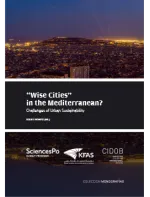Runaway Urbanisation in Tunis: Rethinking the Territorial Box of the Metropolis

By now, the notion of a “Planet of Slums”, in urbanist Mike Davis’s alluring apothegm, has become a way for many to see the urban question in the Global South (Davis, 2007). This pathology has not spared Tunis, Tunisia’s capital and biggest metropolis. Its symptoms are visible in the city’s physiology: congestion, pollution, metastatic sprawl. These problems overlap and make each other worse in a whirl of socioecological duress. As sprawl seeps into agricultural land, people need to travel further and further to get to work. Since mass transit has been difficult to erect in immiserated, capital-strapped, and socially hollowedout Tunisia, everyone drives or uses jerry-rigged collective taxi services, previously the province of the countryside, where they were called Taxi Rifi – rural taxis. Whether higher-density collective taxis or individual taxis for the middle class, more cars means more and more traffic. Of course, if the poorer portions of the population had private cars, the problem would be even worse. In turn, Tunis emits more and more carbon dioxide and non-greenhouse-gas pollutants, damaging air quality and slowly pushing the country up the ladder of greenhouse gas emitters. These workaday problems of non-functional cities have been paired with endemic and unsolvable unemployment, sectoral and general strikes and mass protests that paralyse roadways, mines and cities, and which occasionally produce an unrest so combustible as to set off immolations – such as the one which led to the tragic death of Mohamed Bouazizi in the interior city of Sidi Bouzid, the spark of the Arab Spring.